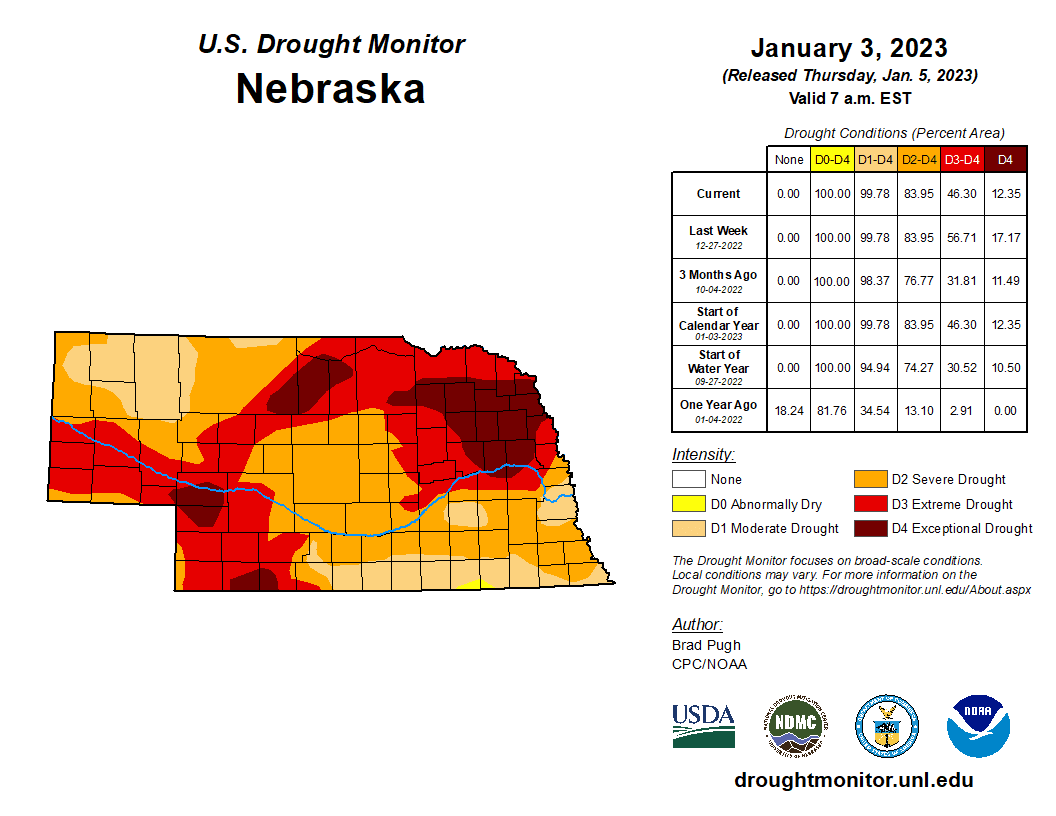
Fighting Drought Stress

VIEW DROUGHT MONITOR >
Currently, parts of Nebraska are some of the driest areas in the country. We have had some precipitation as rain and/or snow form, but it has done little to relieve the long-term effects of the drought. We must develop a consistent wet weather pattern into spring with recurring rainfall to reverse these effects. This also may take a while. We did not get this dry overnight. So, this continued dry pattern may have you thinking of shifting some of your acres to more soybeans than corn.
It may have you thinking about when and how to apply your fertility. Yes, these are things to consider. “Spoon-fed” fertility for corn will likely be more prevalent this coming season if the current weather pattern continues. A typical crop rotation is more in question this winter than in other years, primarily due to the long-term drought effects. Much of this decision lies in where you make the most money per acre. It does every year. Yes, there are agronomic reasons we rotate—fertility credits from soybeans, crop water use requirements, etc., but, as with many other things, it all comes back to money invested, and money returned.
Although soybeans have less overhead in input costs, most agree that, on average, you can make more raising corn than soybeans. This is, of course, if you can raise/maintain the bushel/acre amount of your proven yields, etc.
With input costs at unprecedented levels, I have had conversations with producers thinking they need to find ways to cut input corners such as corn population, fertility levels, etc., trying to save money going into a potentially dry season. Shaving your fertility practices can have more of a long-term effect if you continue that practice over several years. Cutting your population is an easy/quick option but, historically a costly one. Agronomically, this is not the answer.
Consider this: Ideal corn planting populations that maximize yield are the same whether commodity prices are high or low, your yield goals are 175 bu./acre vs. 225 bu./acre, or if planting conditions are wet or dry. For example, cutting populations by 3,000 to 5,000 seeds/a may save between $11-18/acre, but may cost you 6-9 bu/a in yield. The table below shows the percent yield reduction associated with reducing planting populations:
Yield Impact of Reduced Populations — Corn
*Table adapted from Iowa State University
Example: If you are planting corn before May 5 and cut your population from 26,000 to 22,000 to save approximately $14.80 in seed costs, you could lose 4% of yield potential on average. On a base yield of 175 bu./a, that is 7 bushels. If corn is sold at $6.00, you give up $42.00 per acre to save $14.80. Trying to reduce your input costs by cutting back on the seed corn population is not the answer. Remember, corn does not have the same ability to compensate for reduced populations as soybeans.
SOYBEANS
What about soybeans? Can I raise a higher yield with fewer inputs? Do I need more? I will refer back to data from 2021 from the Bayer Research facility at Gothenburg to answer some of this. Granted, Gothenburg is an entirely different growing environment than what you might have here. 12 different management strategies were used:
Bayer High Input Soybean Production Trial >
PRODUCT SPOTLIGHT
With AQUATE MAX®, you can mitigate drought stress by regulating moisture in the root zone to hold nutrients in place. Learn more about this key product.



